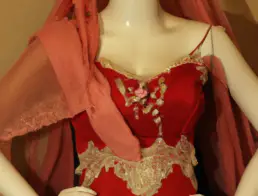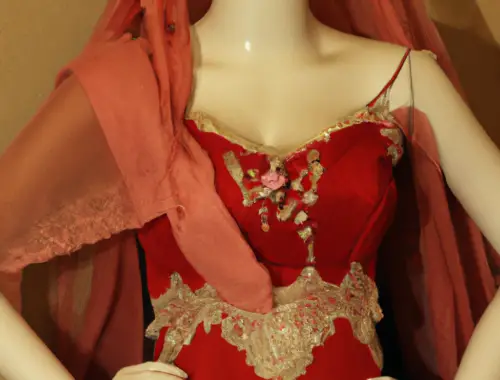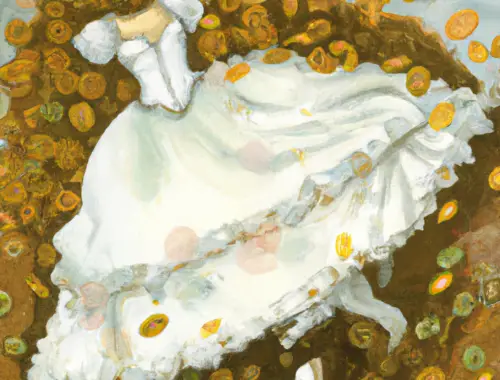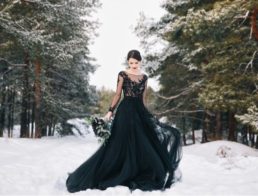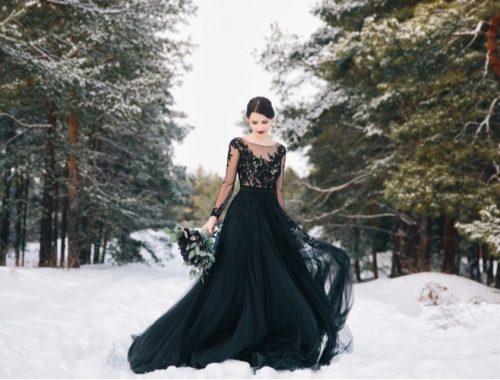Buying a wedding dress can be one of the most important and challenging shopping experiences in your life. It’s a unique purchase because:
- You have to find a way to balance price, fit, style, how it matches with the theme of your wedding and your bridesmaid dresses.
- You’ll wear it once (probably).
- Lots can go wrong! From cost to fit to shipping to style to someone spilling a drink on you at the wrong time there can be all kinds of potential disaster scenarios surrounding your dream dress.
This guide is massive, involved the entire Weddings Digest staff (and lots of external experts), and has tons of data and visualizations so that it answers every Dream Dress question you can think of.
Jump to the section related to your question, but trust: the answer to your question is in here somewhere! We’ll help get you through the dress shopping, fitting, and shipping process in the next several thousand words, so all you have to do is avoid bumping into any red wine-loving clumsy relatives.
In This Article
Dress Shopping Tips from the Pros
To start, we grabbed some quick tips from experienced dress designers and top wedding planners to help give you some context and things to keep in mind as you settle on the right dress for you:
“Choose a dress that makes you feel like the best version of yourself, not a dress that will impress others.”
– Kristin Banta, wedding planner
“Keep an open mind when trying on dresses. You might be surprised at what looks best on you.”
– Lynn Easton, wedding planner
“Don’t forget about the importance of undergarments. They can make or break the way a dress looks on you.”
– Calder Clark, wedding planner
“Consider the season and location of your wedding when choosing a dress. You don’t want to be too hot or too cold.”
– Marcy Blum, wedding planner
“Don’t be afraid to ask for alterations. A good seamstress can make a dress fit you like a glove.”
– Mindy Weiss, wedding planner
“Don’t forget to consider the practicalities of your dress, like how easy it will be to move around in, sit down in, and use the bathroom in!”
– Michelle Loretta, wedding planner
“If you’re having an outdoor wedding, be mindful of the terrain when choosing your shoes and dress length.”
– Jove Meyer, wedding planner
“Don’t be afraid to mix and match different elements of dresses to create your perfect look.”
– Sarah Chancey, wedding planner
“Be sure to bring someone with you to your dress appointments who will be honest with you, but also supportive of your vision.”
– Harmony Walton, wedding planner
“Remember that your dress should reflect your personal style, not just what’s trendy at the moment.”
– Alison Rinderknecht, wedding planner
“Choose a dress that flatters your body type, not just one that looks pretty on the hanger.”
– Lazaro Perez, wedding dress designer
“Don’t forget about the importance of accessorizing. The right jewelry and veil can take a dress to the next level.”
– Hayley Paige, wedding dress designer
“Consider the overall aesthetic of your wedding when choosing a dress. You want your dress to fit in with the overall vibe of the day.”
– Monique Lhuillier, wedding dress designer
“Pay attention to the details of the dress, like the fabric and the embellishments. They can make a big difference in the overall look.”
– Randy Fenoli, wedding dress designer
“Don’t forget about the importance of comfort. You want to be able to move and dance in your dress.”
– Vera Wang, wedding dress designer
“Bring pictures of dresses you like to your appointment, but also be open to trying on dresses the consultant suggests.”
– David Tutera, wedding planner and wedding dress designer
“Consider the time of day of your wedding when choosing a dress. A dress that looks great in the daytime might not work as well for an evening wedding.”
– Reem Acra, wedding dress designer
“Remember that your dress should reflect your personality and style, not just what’s trendy or fashionable.”
– Maggie Sottero, wedding dress designer
Wedding Dresses By the Numbers: The Most Interesting Wedding Dress Statistics
Ever wonder what other brides are doing with their dresses? How much they pay or what style they wear? Here are some stats you may find interesting about wedding dresses in general:
- According to a survey by The Knot, the average cost of a wedding dress in the United States is $1,631.
- A study by Brides magazine found that 67% of brides wear a strapless wedding dress.
- The same study found that 22% of brides opt for a dress with sleeves, while 11% choose a halter neckline.
- In terms of dress length, 53% of brides wear a floor-length dress, while 29% choose a gown with a train.
- If you’re looking to save money on your dress, consider buying a used gown. According to a survey by WeddingWire, 25% of brides wear a pre-owned dress.
- Alternatively, you could rent your dress. The same survey found that 5% of brides rent their wedding dress.
- If you’re feeling crafty, you could even make your own dress. A survey by Etsy found that 12% of brides make some or all of their wedding attire themselves.
Remember, the most important thing is that you feel beautiful and comfortable in your wedding dress. Don’t be afraid to try on different styles and explore all your options until you find the dress of your dreams.
Finding the Right Style
Choosing the perfect wedding dress can be a daunting task. It’s important to find a dress that not only suits your personal style but also flatters your body shape. Here are some tips to help you find the right style for you.
Silhouette
The silhouette of a wedding dress refers to its overall shape. There are several different silhouettes to choose from, including:
- A-line
- Ballgown
- Mermaid
- Sheath
Try on dresses with different silhouettes to see which one flatters your body shape the most. Keep in mind that certain silhouettes work better for different body types. For example, A-line dresses are great for hourglass figures while ballgowns can flatter pear-shaped bodies.
Neckline
The neckline of a wedding dress can completely change the look of the dress. There are several different neckline options, including:
- Sweetheart
- V-neck
- Halter
- Off-the-shoulder
Consider your body type and personal style when choosing a neckline. For example, a V-neck can elongate the neck and flatter a larger bust while an off-the-shoulder neckline can accentuate the collarbone and shoulders.Sleeves
Sleeves can add a touch of elegance and sophistication to a wedding dress. There are several different sleeve options, including:
- Cap sleeves
- Long sleeves
- Short sleeves
- Sleeveless
Consider the season and venue when choosing sleeves. For example, long sleeves may be more appropriate for a winter wedding while sleeveless dresses are perfect for a summer beach wedding.
Train
The train of a wedding dress refers to the fabric that extends beyond the hemline of the dress. There are several different train options, including:
- Sweep train
- Chapel train
- Cathedral train
- Royal train
Consider the formality of your wedding when choosing a train. For example, a sweep train may be more appropriate for a casual beach wedding while a cathedral train can add drama to a formal church wedding.
Types of Wedding Dresses
We’ve broken down our top picks in a variety of different wedding dress categories (you can find those at the links below) and of course if you’re in the early stages of your dress search understanding the options for different dress types is useful too. Below are a number of the most popular dress types (not just style types, but popular colors and options for specific wedding themes).
Beach Wedding Dresses
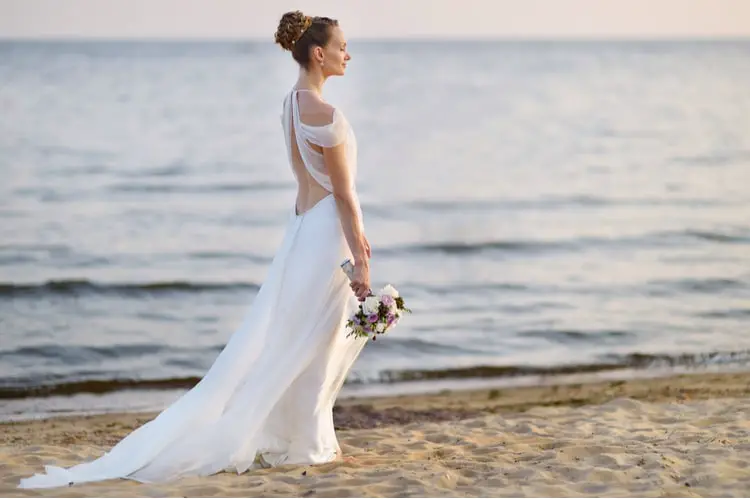
Beach wedding dresses are designed with light, flowing fabrics and simple silhouettes to complement the casual, laid-back atmosphere of a beach wedding. They often feature spaghetti straps or strapless designs, allowing brides to stay cool and comfortable.
Black Wedding Dresses
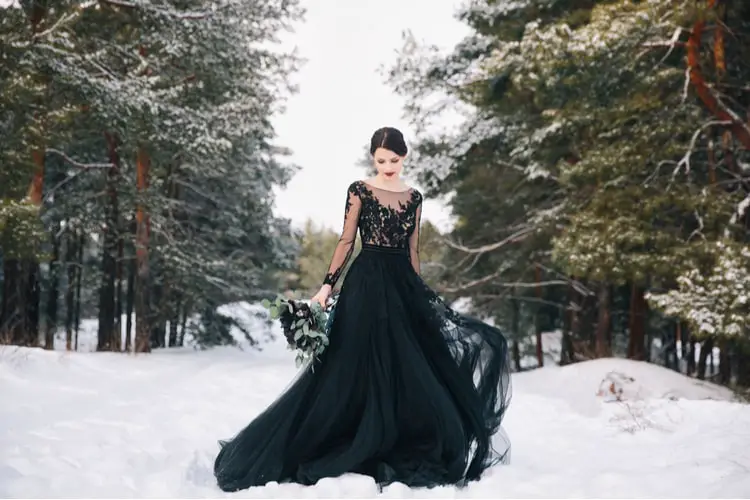
For the non-traditional bride, black wedding dresses make a bold statement. These elegant and dramatic gowns come in various styles and designs, from lace overlays to stunning embellishments.
Blue Wedding Dresses

Blue wedding dresses offer a unique and memorable alternative to traditional white gowns. With shades ranging from soft pastels to deep, rich hues, there is a perfect blue gown for every bride.
Casual Wedding Dresses
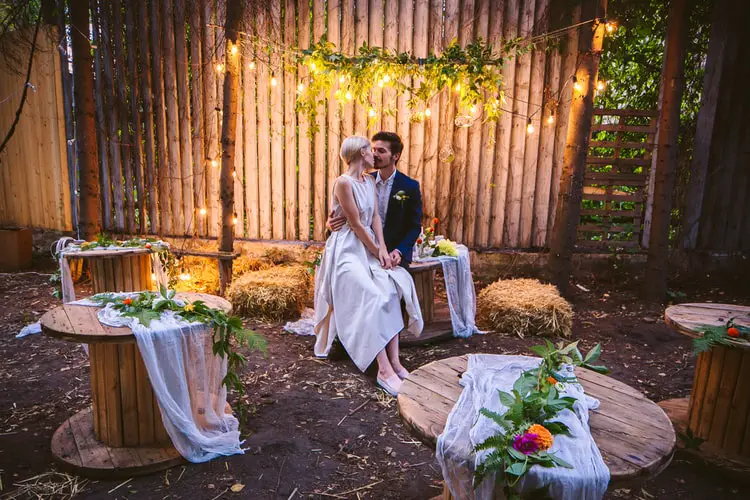
Perfect for smaller, intimate weddings, casual wedding dresses focus on simplicity and comfort. These gowns often have minimal detailing and can be worn in various settings, from backyard ceremonies to city hall weddings.
Indian Wedding Dresses

Indian wedding dresses are known for their vibrant colors, intricate embroidery, and luxurious fabrics. Traditional options include lehengas, sarees, and Anarkali suits, with modern interpretations often combining Western and Indian styles.
Lace Wedding Dresses

Lace wedding dresses exude a timeless elegance, with intricate patterns and delicate detailing. They come in a variety of styles, from vintage-inspired gowns to modern, minimalist designs.
Long Sleeve Wedding Dresses
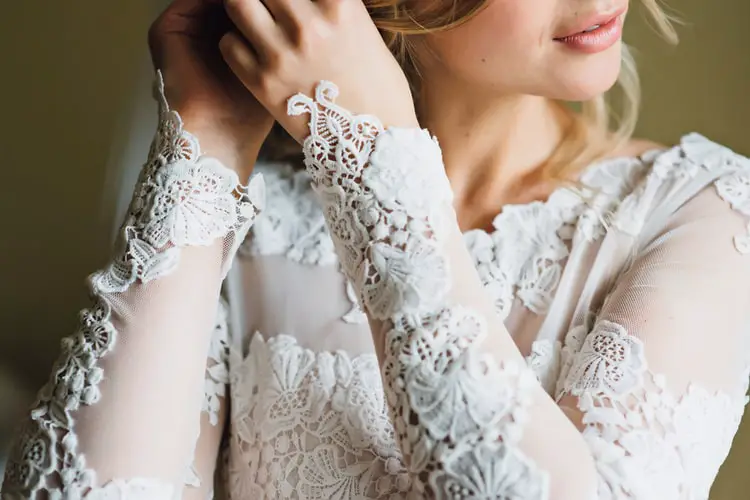
Long sleeve wedding dresses offer a classic and sophisticated look, providing extra coverage for cooler weather or conservative settings. These gowns can feature lace, illusion, or embellished sleeves, adding a touch of glamour to any bridal ensemble. Find the best long sleeve wedding dresses here:
Mermaid Wedding Dresses

Mermaid wedding dresses accentuate a bride’s curves with their fitted bodice and flared skirt, creating a stunning silhouette. Ideal for those looking to make a statement, these gowns are both elegant and dramatic. Discover the best mermaid wedding dresses here:
Modest Wedding Dresses
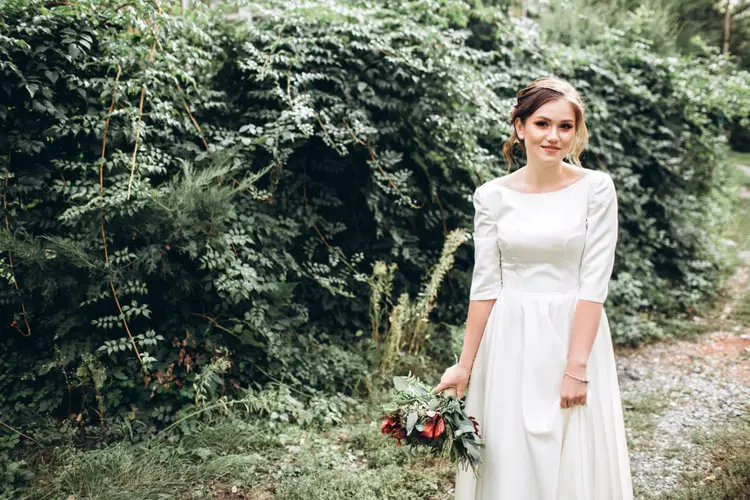
Modest wedding dresses offer more coverage while maintaining a stylish and sophisticated look. They often feature higher necklines, long sleeves, and fuller skirts, catering to brides who prefer a more conservative style.
Red Wedding Dresses
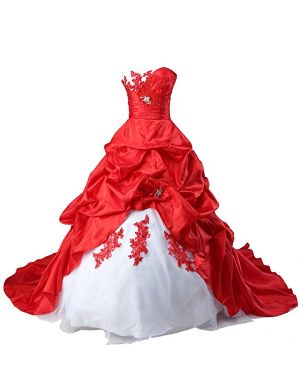
Red wedding dresses make a bold and vibrant statement, symbolizing love and passion. These eye-catching gowns come in various shades and styles, from deep crimson to bright cherry red.
Sexy Wedding Dresses

Sexy wedding dresses are designed to showcase a bride’s figure, with daring necklines, low backs, and form-fitting silhouettes. These gowns are perfect for brides looking to make a sultry statement on their big day.
Short Wedding Dresses

Short wedding dresses are a fun and flirty alternative to traditional full-length gowns. They come in various styles, from vintage-inspired tea-length dresses to modern mini dresses, making them suitable for a range of wedding themes.
Simple Wedding Dresses

Simple wedding dresses focus on clean lines, minimal detailing, and timeless elegance. These gowns often feature classic silhouettes and understated designs, allowing the bride’s natural beauty to shine through.
Tea Length Wedding Dresses
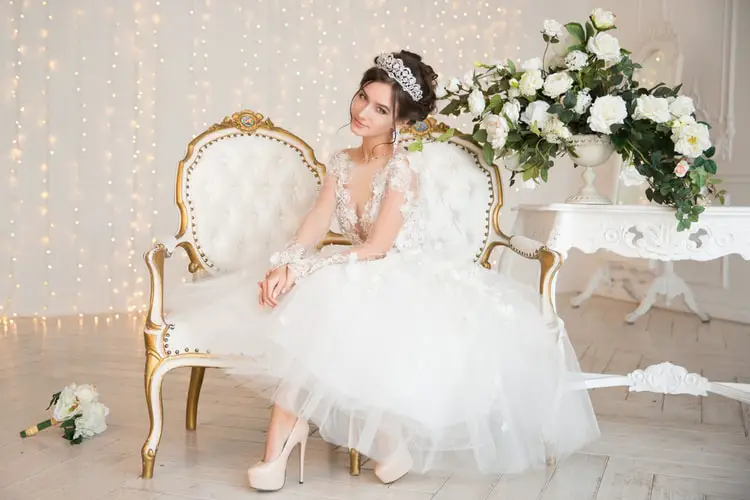
Tea length wedding dresses fall between the ankle and the knee, offering a chic and vintage-inspired look. These gowns are perfect for brides seeking a more casual or retro vibe for their big day.
Turkish Wedding Dresses

Turkish wedding dresses combine traditional elements with modern designs, resulting in stunning and unique gowns. These dresses
often feature intricate embroidery, rich fabrics, and eye-catching details that pay homage to Turkey’s rich cultural heritage.
With such a diverse array of wedding dress types available, every bride can find the perfect gown to suit her personal style, theme, and cultural background. From traditional white gowns to bold, colorful alternatives, the options are endless for brides seeking their dream dress. By exploring each of these dress types, you can ensure that your wedding day look is as unique and unforgettable as the love you share with your partner.
Choosing the Right Fabric
One of the most important decisions you’ll make when ordering your wedding dress is choosing the right fabric. The fabric you choose will affect the overall look and feel of your dress, as well as how comfortable you feel on your big day. Here are some of the most popular fabrics to consider:
Lace
Lace is a timeless and romantic choice for wedding dresses. It is a delicate fabric that adds texture and dimension to your dress. Lace can be used as an overlay or as a main fabric, and it comes in a variety of patterns and styles. Some popular types of lace include Chantilly, Alencon, and Guipure.
Satin
Satin is a luxurious and elegant fabric that has a smooth and shiny finish. It is a popular choice for formal wedding dresses and adds a touch of glamour to your look. Satin comes in a variety of weights and can be used for both the body of the dress and the lining.
Tulle
Tulle is a lightweight and airy fabric that is often used for ballgown-style wedding dresses. It adds volume and movement to your dress and creates a dreamy, romantic look. Tulle can be used as an overlay or as a main fabric, and it comes in a variety of colors and finishes.
Chiffon
Chiffon is a light and flowy fabric that is perfect for summer weddings or beach weddings. It is a popular choice for destination weddings because it is easy to pack and transport. Chiffon comes in a variety of colors and finishes, and it can be used for both the body of the dress and the lining.
When choosing the right fabric for your wedding dress, it’s important to consider the style of dress you want, the season and location of your wedding, and your personal preferences. Keep in mind that some fabrics are more forgiving than others, so if you’re worried about comfort or fit, consider choosing a fabric that has some stretch or give to it.
Selecting the Perfect Size
Choosing the right size for your wedding dress is crucial to ensure that it fits you perfectly and looks stunning on your big day. Here are some tips to help you select the perfect size:
Get Professional Measurements
It’s important to get professional measurements taken by a bridal attendant at each salon you visit. They will measure you multiple times to ensure accuracy. Don’t rely on your regular dress size, as wedding dress sizes can be different from regular clothing sizes.
Consider Alterations
Most wedding dresses will require some alterations to fit you perfectly. Keep in mind that alterations can take several weeks, and there are certain restrictions on how much a dress can be taken out or how much your wedding dress can be taken in, so plan accordingly. It’s better to order a dress that’s slightly too big than too small, as it can always be taken in.
Don’t Obsess Over the Number
Remember that wedding dress sizes are just numbers, and they don’t define youor your body. Focus on finding a dress that makes you feel beautiful and confident, regardless of the size on the tag. Some wedding dresses are designed to flatter various body types.
Check the Sizing Chart
Each designer may have their own sizing chart, so make sure to check it before ordering. For example, Stella York wedding dresses may have a different sizing system than other designers. If you’re between sizes, it’s usually recommended to order the larger size and have it altered to fit perfectly.
Consider Your Wedding Date
If your wedding is several months away, consider ordering the dress in a slightly larger size to account for any weight ding-dresses/”>the availability of plus-size wedding dresses if necessary. These factors can impact the fit and overall look of the dress on your body.
Consider Built-In Support
Some wedding dresses come with built-in bras, which can provide additional support and comfort. Be sure to ask about this feature when trying on dresses, as it may influence your decision.
By following these tips, you can select the perfect size for your wedding dress and ensure that it fits you like a glove on your big day.
fluctuations. If your wedding is only a few weeks away, it’s best to order the size that currently fits you best.
Height and Plus Size Options
When selecting a wedding dress, it’s important to consider the height for which wedding dresses are made and the availability of plus-size wedding dresses if necessary. These factors can impact the fit and overall look of the dress on your body.
Consider Built-In Support
Some wedding dresses come with built-in bras, which can provide additional support and comfort. Be sure to ask about this feature when trying on dresses, as it may influence your decision.
By following these tips, you can select the perfect size for your wedding dress and ensure that it fits you like a glove on your big day.
Customizing Your Dress
Adding Sleeves
If you want to add sleeves to your wedding dress, there are a few options to consider. You can choose between long, short, or cap sleeves, and you can opt for lace or sheer fabric. Sleeves can add a touch of elegance and modesty to your dress, and they can also help you stay warm if you’re getting married in a cooler climate. Here are some popular sleeve styles:
- Cap sleeves: These sleeves cover only the top of the shoulder and are perfect for a vintage or retro look.
- Short sleeves: These sleeves end just above or below the elbow and can be made of lace or sheer fabric.
- Long sleeves: These sleeves cover the entire arm and can be fitted or loose. They can be made of lace, sheer fabric, or a combination of both.
Changing the Neckline
The neckline of your dress can dramatically change the overall look and feel of your gown. Here are some popular neckline options:
| Neckline Style | Description |
|---|---|
| V-neck | A neckline that dips down in a V-shape, elongating the neck and creating a flattering silhouette. |
| Sweetheart | A heart-shaped neckline that accentuates the bust and creates a feminine look. |
| Halter | A neckline that ties around the neck, exposing the shoulders and upper back. |
| Off-the-shoulder | A neckline that sits just below the shoulders, creating a romantic and feminine look. |
Adding a Belt
A belt can add definition to your waistline and create a more structured look. You can choose between a thin or thick belt, and you can opt for a simple or embellished design. Here are some popular belt styles:
- Rhinestone belt: Adds sparkle and glamour to your dress.
- Floral belt: Adds a touch of whimsy and romance to your dress.
- Satin belt: Adds a classic and elegant touch to your dress.
Custom Embroidery
Custom embroidery can add a personal touch to your dress and make it truly one-of-a-kind. You can choose to embroider your initials, wedding date, or a special message onto your dress. Embroidery can be added to the bodice, sleeves, or skirt of your dress, and it can be done in a variety of colors and styles.
Wedding Dress Pricing Guide
Your wedding dress is one of the most important purchases you’ll make for your big day. It’s also one of the most expensive. Understanding how wedding dresses are priced can help you make informed decisions about your purchase and potentially save you some money.
Here’s what you need to know.
How Much Do Wedding Dresses Really Cost?
Obviously the answer here can vary greatly based on the brand and the style of dress, but here are some general ranges at major retailers and for major brands:
| Brand / Retailer | Price Range (USD) |
|---|---|
| David’s Bridal | $99 – $2,500 |
| BHLDN | $300 – $4,000 |
| Kleinfeld Bridal | $1,000 – $20,000 |
| Vera Wang | $1,500 – $25,000 |
| Maggie Sottero | $800 – $3,000 |
| Pronovias | $1,000 – $10,000 |
| Alfred Angelo | $500 – $2,500 |
| J.Crew | $300 – $1,500 |
| Anthropologie | $300 – $2,000 |
| Reformation | $500 – $4,000 |
Factors that Affect Wedding Dress Pricing
- Fabric: The type of fabric used for your wedding dress can significantly impact its price. High-quality fabrics like silk, lace, and tulle are more expensive than synthetic materials.
- Design: Intricate designs, beading, and embroidery can also increase the cost of your dress. Custom-made dresses or designer dresses are often more expensive due to the time and skill required to create them.
- Brand: The brand of the dress can also affect its price. Designer dresses from well-known brands like Vera Wang or Monique Lhuillier can cost thousands of dollars.
- Store: The store where you purchase your dress can also impact its price. Bridal boutiques often charge more than department stores or online retailers.
Tips for Saving Money on Your Wedding Dress:
Consider renting your dress instead of buying it. This can be a great option if you’re on a tight budget.
Look for sample sales or trunk shows where you can purchase designer dresses at a discounted price.
Consider buying a pre-owned dress or having one custom-made.
Shop online for deals and discounts.
More Dress Pricing Tips
If you’re still unsure about how much you should be spending on your wedding dress, there are several helpful resources available to guide you through the process. For instance, you might want to explore a comprehensive guide to custom wedding dresses to better understand the costs associated with tailor-made gowns. If you’re a fan of Disney, learning about how much Disney wedding dresses cost in the UK could help you make a decision.
Weighing the pros and cons of renting vs. buying wedding dresses can also be beneficial, especially if you’re on a tight budget. To get an idea of specific designer dress prices, take a look at how much Eddy K wedding dresses cost. Additionally, you might be interested in determining whether it’s cheaper to buy or make your own wedding dress.
Another important aspect to consider is payment. Understanding if you normally pay for a wedding dress in full can help you budget accordingly. If you’re wondering about the average cost of a wedding dress, check out this guide on whether $1000 is a lot for a wedding dress. Lastly, it’s important to be aware of potential additional costs, such as whether you should pay to try on wedding dresses.
By understanding how wedding dresses are priced and exploring your options through these resources, you can find the perfect dress for your big day without breaking the bank.
Ordering Your Dress
Timeline
When it comes to ordering your wedding dress, it’s important to give yourself plenty of time. Most bridal shops recommend ordering your gown at least 6-8 months before your wedding day. This allows time for the dress to be made to your measurements, shipped to the store, and for any necessary alterations to be made. However, some designers may require up to 12 months for custom orders, so be sure to check with your boutique for their specific timeline.
When is Too Early to Order a Wedding Dress?
While it’s important to give yourself enough time to order your dress, it’s also possible to order too early. If you’re planning a long engagement, it may be tempting to order your dress right away. However, styles and trends can change over time, so it’s best to wait until you’re closer to your wedding date to ensure you choose a dress that fits your current style and preferences. For instance, ordering a dress 18 months in advance might be too soon, while 15 months could be a more reasonable timeframe.
When is it Too Late to Order a Wedding Dress?
If you’re getting close to your wedding date and haven’t yet ordered your dress, don’t panic. Many bridal shops offer rush options for an additional fee, and some designers even offer off-the-rack options that can be purchased and altered quickly. However, keep in mind that rushing your dress order can limit your options and increase your stress levels. For example, ordering a dress 7 months or 6 months before the wedding may be considered late, while 5 months could be just enough time to get your wedding dress. If you find yourself with only 4 months to spare, it may still be possible to secure your dream gown. And even if you’re down to the wire with just 3 months left, there are last-minute bridal gown options available.
To avoid any potential pitfalls, start researching wedding dresses early enough to order your dress as soon as you begin your wedding planning journey. This will help you better understand the timelines involved and ensure you don’t miss out on your perfect dress. Remember that 10 months is often considered an ideal timeframe for finding and ordering a wedding dress, giving you ample time for any necessary alterations and fittings.
Payment Options
When ordering your dress, be sure to ask about payment options. Many bridal shops require a deposit at the time of ordering, with the remainder due upon pickup. Some shops may also offer financing options or payment plans to help make your dream dress more affordable.
Shipping and Delivery
Once your dress is ready, it will be shipped to the bridal shop for pickup or directly to your home. Be sure to ask about shipping options and fees, and confirm the delivery date to ensure your dress arrives in plenty of time for your wedding day. It’s also a good idea to have a backup plan in case of any shipping delays or issues.
Wedding Dress Care Tips
Once you’ve found your dream dress, here are some tips on how to care for your wedding dress so that it stays beautiful and pristine for years to come:
| Tip | Description |
|---|---|
| Store your dress properly | Hang it up in a cool, dry place, and avoid wire hangers. |
| Clean and preserve your dress | Take it to a professional cleaner that specializes in wedding dresses. |
| Handle with care | Be gentle when zipping or buttoning it up and avoid touching it with dirty hands. |
| Avoid eating or drinking near your dress | Food and drink stains can be tough to remove and can cause permanent damage. |
| Transportation | Keep your dress in a garment bag or box and avoid leaving it in direct sunlight or in a hot car. For wedding dresses made of delicate materials like crepe, make sure to lay it flat instead of hanging to avoid creasing the fabric. |
| Choose the right storage location | Store your dress in a cool, dry place away from sunlight, humidity, and pests. For stretchy wedding dresses, make sure to lay it flat instead of hanging to avoid stretching out the fabric. |
By following these tips, you can ensure that your wedding dress looks beautiful on your special day and for years to come. Remember to handle it with care, store it properly, and clean and preserve it after the wedding. With a little bit of TLC, your dress will be a cherished reminder of your special day.
Frequently Asked Questions
When it comes to wedding dress shopping, there are always questions. Here are some of the most frequently asked questions we receive:
How long does it take to order a wedding dress?
Plan to order your dress at least 9-12 months prior to your wedding date. Dresses are made to order and can take up to 5-7 months to produce, plus 2-3 months for tailoring. Rush orders may be available for an additional fee.
How many stores should I visit when searching for a wedding dress?
We suggest visiting three to five stores to find the perfect dress. This will give you a wide selection without feeling overwhelmed. Keep in mind that each store may carry different designers and styles, so it’s worth visiting multiple stores to find your dream dress.
What should I bring to my bridal appointment?
Bring any undergarments or shapewear you plan to wear on your wedding day, as well as shoes with a similar heel height. It’s also helpful to bring photos or inspiration of dresses you like to show your stylist.
How do I know what size to order?
Bridal sizing can be different from regular clothing sizes, so don’t be surprised if you need to order a larger size than you typically wear. Your stylist will take your measurements and recommend a size based on the designer’s size chart. Keep in mind that alterations are typically needed to achieve the perfect fit.
What is the payment process for ordering a wedding dress?
Most bridal salons require a deposit when you place your order, with the remaining balance due when the dress arrives. Payment plans may be available, so be sure to ask your stylist about your options.

